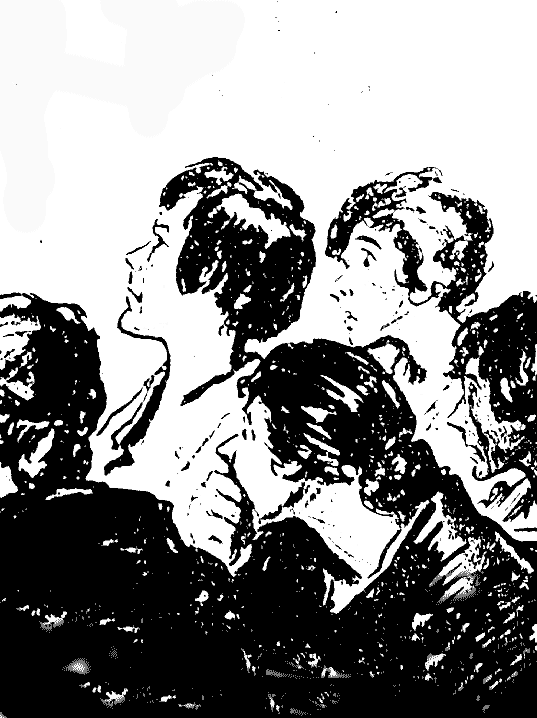“We got the bubble-headed-bleach-blonde who comes on at five,
She can tell you bout the plane crash with a gleam in her eye
It’s interesting when people die, we love dirty laundry …”
— Don Henley
If you want to meet that bubble-head, just drop a Jackson and visit the shiny new Newseum on the Mall in Washington DC. She’s there in her natural element, enshrined in a vast warehouse of media fantasies, in a vacuum so complete that even a news chopper hanging from the ceiling virtually vanishes into irrelevance.
It’s not just the unbelievable architecture that gives you vertigo. The enormous empty space is a perfect reflection of the modern profession: Beautiful exteriors, vacuous interiors. A $450 million monument to a profession that is devouring its young.
It’s a saccharine sepulcher of the supine press. A tomb, not a monument. Or, as Steven Colbert said, a “Newsoleum.”
Wait. Are we being unfair? Gosh! Gee! Whiz! What’s not to like about the press? Even Superman commits journalism. Kent Brockman … Clark Kent … Dan Rather …. whats the diff? And why shouldn’t Fox “News” owner Rupert Murdoch have more or less the same place in the history of the news media as Joseph Pulitzer?
Nausea follows the narcissism
Like the companies that financed it, the Newseum tells one simple story over and over, as if we didn’t get it in the obligatory eight minute intro movie: those men and women of the press are Heroes, risking All for your Right to Know, which is Essential for Democracy. It’s really not such a far-fetched message, but the delivery, in a barrage ofself-righteous blather, provokes a snickering groan from the parents who just want their kids to try being a TV reporter.
So much of what we call history is delivered just to “honor the heroes.” Nearby, the entire Washington Mall was built around the concept, which is, after all, at the root of history itself. In 430 BC, Herodotus, the father of history, wrote about the Trojan Wars in order to “preserve from decay the remembrance of what men have done.”
But if that’s all history was about — honoring the heroes — it would be little more than custodial care in the cemetery of ideas.
The strength of history is the way it provides lessons and serves as a guide. The earliest advocate of this approach to history, and by the way the first war correspondent, was Thucydides. He wrote the History of the Peloponnesian War around 400 BC — not, as he said, to honor heroes, but rather to help future generations learn from the past.
The problem with the Newseum is that its historical approach ignores the lessons and concentrates on heroism. And that’s not the role of a free press in a democracy. You can honor the heroes just as easily in Moscow, Havana, and Bejing as you can in Washington or London or Paris.
What you cant do is print the truth and learn the lessons of the past in Moscow, Havana, and Bejing. This crucial insight into the social role of the press is what’s missing from the Newseum.
Where’s the beef? It’s all baloney
For a media historian, wandering through the Rupert Murdoch hall of press history is like watching a documentary about harp seals while drinking a Canadian Club.
Start with the physical layout of the history section on the Newseum’s fifth floor. An extremely long table in the center of a dark hall contains newspapers that illustrate eras of history, but the hall is too dark to actually read them. And there are too many TV screens blaring, and people moving too quickly, to be able to read in any event.
Future historians will wonder about the earth shaking significance of the Dan Akroyd / Jane Curtin bit on Saturday Night Live in the 70s, when Dan calls Jane “an ignorant slut.” These are words that literally echo down the hall of history.
On the walls you see image after image of the happy corporate media reporter, the one with the expensive hair-do, designer suit and brass check in her purse. They also have legends of the media mixed in with real people. There’s Superman and Clark Kent. And superwoman too. (What newspaper did she work for?)
God forbid we should be exposed to the rough and tumble political creature that used to enjoy standing up to the arrogance of American politicians. He usually had a cheap haircut and a rumpled suit. You wont see Russell Baker’s editor at the Baltimore Sun yelling that he “wouldn’t wipe his ass with a police captain.” You wont hear H.L. Mencken railing at the grotesque stupidity of the South, the “Sahara of the bozarts” (beaux arts). You wont see Mark Twain telling a lynch-happy governor to “get down on his knees” and pray for forgiveness. The few real people that are mentioned at the Newseum have such a thick gloss lacquered over their legends that their own children wouldn’t recognize them.
Carl Sagan once said that the slow decay of substantive content of the media was a sure sign of pending collapse. He feared the day, he said, when the “awesome technological powers are in the hands of a very few, and no one representing the public interest can even grasp the issues; when the people have lost the ability to set their own agendas or knowledgeably question those in authority; when, clutching our crystals and nervously consulting our horoscopes, our critical facilities in decline, unable to distinguish between what feels good and what’s true, we slide, almost without noticing, back into superstition and darkness.”
If anything, the Newseum seems to proclaim this Information Apocalypse like Simpsons TV anchor Kent Brockman, a professional sycophant always ready to welcome “our new masters” with open arms.
Well, OK, at least the Newseum does feel good, even if it can’t help us distinguish what’s true about the press. Hey, there are FOUR dimensional movies – yes, FOUR dimensions — about Nellie Bly and Isaiah Thomas and Edward R. Murrow — well, not movies really, just ultra-fast clips for compressed attention spans. She went to a madhouse, he moved a printing press, somebody spoke under a bombardment, and it was … over. Lights on. Keep moving folks.
Missing Lessons
What’s missing? If the information revolution ever produces a Madame Defarge, she will get a few yards of scarf out of this one.
What’s missing is context.
For instance, in 1993 Rupert Murdoch (a Newseum financier) gave a speech in London saying that “advances in the technology of telecommunications have proved an unambiguous threat to totalitarian regimes everywhere.” By the early 21st century, Murdoch and News Corporation, along with Google and the rest of the supposedly free corporate press, were on bended knee to the Chinese, hoping that by betraying their history they would grasp a piece of their supposedly lucrative new market.
Gawd, what’s missing from the Newseum ..
— Almost anything outside the American experience. You have to wonder if Newseum historians (does it even have historians?) actually considered the folly of a nationalistic museum focused on the US press in an era of international communication. It’s an automatic anachronism.
(The exception, of course, is the international memorial to slain journalists, an extremely important and moving monument to serious heroism that we never had to pay $20 to see when it was across the river in Rosslyn.)
What’s missing …
— The idea that the First Amendment covers everyone’s right to speak, and that everyone has a stake in the way information is handled in a democracy.
— Lessons about questioning authority in an age of mega-technology. Who protects the public interest when the press, out of ignorance or fear, aligns itself with the powerful?
— What ever happened to Pulitzer’s idea about never lacking sympathy with the poor?
— Lessons about the influence of hate speech in mass communication, such as what happened after the Klan-worshiping movie Birth of a Nation was shown nationwide in 1915, or the role of media in the “Indian Wars” of the 1870s-90s. Not to mention the very central role of the German media in creating Holocaust, or the media of Cambodia, Rwanda or Serbia in creating genocide in those nations.
— Lessons about the constructive and visionary role of the media, for instance, in the Civil Rights movement, or the way Pulitzer avoided war in 1894, or in supporting the Marshall Plan in the post WWII era. Yes, there is a very short film about civil rights featuring Claude Sitton, who was at the center of that cyclone. But the film just shows Calude and some civil rights footage. It lacks a sense of what the beat was about and why the reporting made a difference.
— Lessons about invoking exaggerated fear responses in audiences and what that can do in terms of mass psychology. The Bowling for Columbine / Cultivation Theory view of media as propagators of socially damaging paranoia.
— The largest missing piece of the media puzzle is the information revolution, you know, the one that is eroding the financial base that constructed the Newseum in the first place. You dont see it in the Newseum, of course, but it’s the elephant in the living room.
For a profession that once prided itself on seeing through the hype and BS of political life, it seems the rankest hypocrisy to avoid turning that Superman X-ray vision on its own historical myths.
Further Reading
- Davin Hutchins, American News Project — The House that Rupert Built
- Fade to Black — Today’s Word: Newsoleum
- David Essex, Flak Magazine — How the Newsoleum buried the lead
- Jon Friedman, Marketwatch — The new facility just seems self-indulgent
- Jack Shafer, Slate — … Boycott journalism’s monument to itself.

 Revolutions in Communication
Revolutions in Communication Mass Media & Environmental Conflict
Mass Media & Environmental Conflict